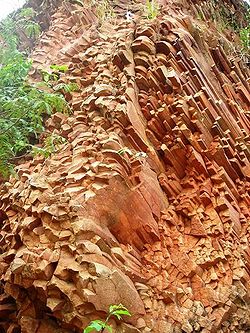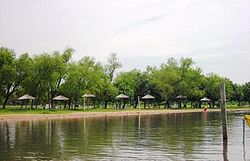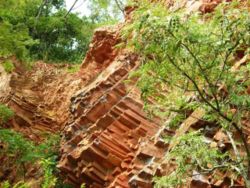
Areguá
Encyclopedia
Areguá is a city in Paraguay
; located 28 km away from the capital city Asunción
. It is the capital of Central
. Probably the best feature of this Paraguayan town is its geographical location; it lays between a group of rolling hills with a distinctive rock formation (found only in 3 places in the world) and a beautiful blue lake, Ypacaraí lake
. The topography of the surroundings gives this town a unique natural charm. The colonial architecture, largely preserved, along with its original cobble stone streets makes this small town a very quaint destination. Here, one can find magnificent mansions, which are laid out as surrounding corridors enclosing a central plaza (usually a beautiful flowered garden). It is also known as the "city of strawberries" because of the large production of strawberries, the best in Paraguay. The city of Areguá is also home to skilled artisans who showcase their works in expos held throughout the year. The History Museum of Crafts is located in this city. There's also many art galleries with a wide variety of antiques and works of art from the last century.
, Indians who lived in this area before the Spanish colonization. This group was called "Ariguá", which means "those from above", because of their location in a quite high region.
The nice temperature makes Areguá a great tourist attraction, especially because of its privileged location on the Ypacarai Lake
.

in 1538 in the territory of an Indian people who lived in that land, on the banks of the Ypacarai Lake. Its inhabitants lived in the area surrounding the present church of Areguá.
At the beginning of the Spanish colonization, the town was a cattle raising farm of Mercedarian origin.
At the end of the 19th century, it was developed as a summer city where most of the writers, artists and intellectuals lived in the hot months.
 Apart from being an important income resource, this fruit has its own history. In fact, the production of this fruit is a particular characteristic of Areguá. According to local people, back to 1920, in The Estanzuela Settling, a farmer put all his strength in the strawberry growing.
Apart from being an important income resource, this fruit has its own history. In fact, the production of this fruit is a particular characteristic of Areguá. According to local people, back to 1920, in The Estanzuela Settling, a farmer put all his strength in the strawberry growing.
He traveled to the town of Areguá to sell his crop in small baskets. Due to the great success, the strawberry plantation extended to all over the nearby farms, becoming, nowadays, the most important product of the zone. In the harvest months the traditional annual "Strawberry Festival" is celebrated. At the festival, you can taste delicious marmalades, jellies, juices and pies.
This town is also known by its pottery crafts, activity which involves a very important part of the people. Its industrial index is emergent.
 Areguá is a lovely town which preserves pretty colonial houses with wide corridors and a particular style. These buildings date from the time when Areguá was mainly a summer town where families from Asunción had their residences to spend the summer. This particular feature makes Areguá an ideal peaceful and warm city to receive visitors.
Areguá is a lovely town which preserves pretty colonial houses with wide corridors and a particular style. These buildings date from the time when Areguá was mainly a summer town where families from Asunción had their residences to spend the summer. This particular feature makes Areguá an ideal peaceful and warm city to receive visitors.
Undoubtedly, the "Avenida del Lago" (Lake Avenue) is a nice excursion to senses. It is extended from the highest place where the main church is located descending to the bank of the Lake where the Municipal Beach is. This route is considered the historical area of the town and was declared a National Patrimony by the Paraguayan Parliament in 1997. The Ypacarai Lake, without a doubt, is the main tourist attraction. It offers a privileged landscape.
In this town there is an ecological club called "Isla Valle" where besides enjoying a beautiful nature you can also go fishing using the practice "pesque y pague" (fish and pay).
Another attraction is the variety of pottery handcraft made by the people in town. The Centro Artesanal de la Cuenca (Handcraft Centre of the basing) is a site of exhibition and selling where craftmen from all over the region are gathered.
The Cultural Centre "Estacion A" is an establishment which provides tourist information to visitors; it has also a museum of photography in the antique train station opened to public every two weeks and a guide service to visit the historical sites is available.
There are many art galleries such as: "Guggiari Arte", "Luis Cogliolo Galería de Arte", "Paseo La Candelaria", "Areguá pesebres" and "El Cántaro" in the town. An interesting place to visit is the "Museo las Margaritas" located on one side of the "La Candelaria" church.
As it is a very antique town it is interesting to investigate about the large number of ghost apparitions among the local people, which give a particular charm to the people culture of the town.

 The Koi and Chorori hills are of great tourist attraction. The Koi hill is known by its formations of hexagonal sandstones, similar to a bee honeycomb, unique in Latin America. Only Canada and South Africa
The Koi and Chorori hills are of great tourist attraction. The Koi hill is known by its formations of hexagonal sandstones, similar to a bee honeycomb, unique in Latin America. Only Canada and South Africa
have this geological phenomenon and they are protected as a Human Patrimony in both countries.
This hill was declared a Natural Monument in 1993. One can see that they are built by horizontal blocks of igneous sandstones, and that is the reason why the hill is a rarity.
Both Hills (Koi and Chorori) amount 26 ha. They have many owners in spite of a decree stated by the Executive Power which declared them a National Monument.
This is due to the Paraguayan government hasn’t paid the owners for the expropriation yet. The lack of interest and awareness by the authorities are remarkable in the environmental area in Paraguay.
is native of Areguá. He was born on April 20, 1907. This great writer developed most of his work in this town, and has a lot of affection for it. The various stories of this author can be seen in the descriptions of the landscapes of this region. In his famous novel "La Babosa" he makes a detailed narration of manners and criticism of the people in town.
The corpse of Casaccia rest in his hometown, in spite of having lived his last years in Buenos Aires
, as it was his last will. On his grave the sculptor Herman Guggiari built a sculpture in his memory.
Paraguay
Paraguay , officially the Republic of Paraguay , is a landlocked country in South America. It is bordered by Argentina to the south and southwest, Brazil to the east and northeast, and Bolivia to the northwest. Paraguay lies on both banks of the Paraguay River, which runs through the center of the...
; located 28 km away from the capital city Asunción
Asunción
Asunción is the capital and largest city of Paraguay.The "Ciudad de Asunción" is an autonomous capital district not part of any department. The metropolitan area, called Gran Asunción, includes the cities of San Lorenzo, Fernando de la Mora, Lambaré, Luque, Mariano Roque Alonso, Ñemby, San...
. It is the capital of Central
Central Department
Central is a department in Paraguay. The capital is Areguá. With its 1,929,834 inhabitants it is the most populated of the 17 departments of Paraguay.-Boundaries:*North: the departments of Cordillera and Presidente Hayes....
. Probably the best feature of this Paraguayan town is its geographical location; it lays between a group of rolling hills with a distinctive rock formation (found only in 3 places in the world) and a beautiful blue lake, Ypacaraí lake
Ypacaraí Lake
Ypacaraí Lake is a major waterbody located in Paraguay about 25 km east of Asunción. The lake lies in the western part of the Asunción-Sapucai-Villarrica graben, a tectonic depression of Mesozoic age, and drains to the northwest trough Salado River into Paraguay River...
. The topography of the surroundings gives this town a unique natural charm. The colonial architecture, largely preserved, along with its original cobble stone streets makes this small town a very quaint destination. Here, one can find magnificent mansions, which are laid out as surrounding corridors enclosing a central plaza (usually a beautiful flowered garden). It is also known as the "city of strawberries" because of the large production of strawberries, the best in Paraguay. The city of Areguá is also home to skilled artisans who showcase their works in expos held throughout the year. The History Museum of Crafts is located in this city. There's also many art galleries with a wide variety of antiques and works of art from the last century.
Toponymy
Areguá takes its name from the former settlers, the Mbyá GuaraníMbyá Guaraní
Mbyá Guaraní is a Tupi–Guaraní language spoken 16,050 Brazilians, 3,000 Argentines, and 8,000 Paraguayans. It is 75% lexically similar to Paraguayan Guaraní.Mbyá Guaraní is one of a number of "Guaraní dialects" now generally classified as distinct languages....
, Indians who lived in this area before the Spanish colonization. This group was called "Ariguá", which means "those from above", because of their location in a quite high region.
Climate
The climate in this town is warm. In the summer the temperature are the highest, reaching the 40°C. The lower temperatures are in the winter, reaching 0°C. In relation to rains, the rainiest months are between January and April.The nice temperature makes Areguá a great tourist attraction, especially because of its privileged location on the Ypacarai Lake
Ypacaraí Lake
Ypacaraí Lake is a major waterbody located in Paraguay about 25 km east of Asunción. The lake lies in the western part of the Asunción-Sapucai-Villarrica graben, a tectonic depression of Mesozoic age, and drains to the northwest trough Salado River into Paraguay River...
.

Demography
Areguá has 67.847 inhabitants in total, of which 33.977 are males and 33.870 females, according to the projections made by The General Direction in Statistics, Surveys and Census. (Projection 2008)History
Originally, this town was named "Tapaichuá", founded by Domingo Martínez de IralaDomingo Martínez de Irala
Domingo Martínez de Irala was a Spanish Basque conquistador.He headed for the Americas in 1535 enrolled in the expedition of Pedro de Mendoza and participated in the founding of Buenos Aires...
in 1538 in the territory of an Indian people who lived in that land, on the banks of the Ypacarai Lake. Its inhabitants lived in the area surrounding the present church of Areguá.
At the beginning of the Spanish colonization, the town was a cattle raising farm of Mercedarian origin.
At the end of the 19th century, it was developed as a summer city where most of the writers, artists and intellectuals lived in the hot months.
The strawberry

He traveled to the town of Areguá to sell his crop in small baskets. Due to the great success, the strawberry plantation extended to all over the nearby farms, becoming, nowadays, the most important product of the zone. In the harvest months the traditional annual "Strawberry Festival" is celebrated. At the festival, you can taste delicious marmalades, jellies, juices and pies.
Economy
The strawberry growing is one of the main activities of the inhabitants. Every August it is held the "Strawberry Festival" where the producers exhibit their natural production or their by-products elaborated from the fruit.This town is also known by its pottery crafts, activity which involves a very important part of the people. Its industrial index is emergent.
Tourism

Undoubtedly, the "Avenida del Lago" (Lake Avenue) is a nice excursion to senses. It is extended from the highest place where the main church is located descending to the bank of the Lake where the Municipal Beach is. This route is considered the historical area of the town and was declared a National Patrimony by the Paraguayan Parliament in 1997. The Ypacarai Lake, without a doubt, is the main tourist attraction. It offers a privileged landscape.
In this town there is an ecological club called "Isla Valle" where besides enjoying a beautiful nature you can also go fishing using the practice "pesque y pague" (fish and pay).
Another attraction is the variety of pottery handcraft made by the people in town. The Centro Artesanal de la Cuenca (Handcraft Centre of the basing) is a site of exhibition and selling where craftmen from all over the region are gathered.
The Cultural Centre "Estacion A" is an establishment which provides tourist information to visitors; it has also a museum of photography in the antique train station opened to public every two weeks and a guide service to visit the historical sites is available.
There are many art galleries such as: "Guggiari Arte", "Luis Cogliolo Galería de Arte", "Paseo La Candelaria", "Areguá pesebres" and "El Cántaro" in the town. An interesting place to visit is the "Museo las Margaritas" located on one side of the "La Candelaria" church.
As it is a very antique town it is interesting to investigate about the large number of ghost apparitions among the local people, which give a particular charm to the people culture of the town.


South Africa
The Republic of South Africa is a country in southern Africa. Located at the southern tip of Africa, it is divided into nine provinces, with of coastline on the Atlantic and Indian oceans...
have this geological phenomenon and they are protected as a Human Patrimony in both countries.
This hill was declared a Natural Monument in 1993. One can see that they are built by horizontal blocks of igneous sandstones, and that is the reason why the hill is a rarity.
Both Hills (Koi and Chorori) amount 26 ha. They have many owners in spite of a decree stated by the Executive Power which declared them a National Monument.
This is due to the Paraguayan government hasn’t paid the owners for the expropriation yet. The lack of interest and awareness by the authorities are remarkable in the environmental area in Paraguay.
Famous people
The Paraguayan writer Gabriel CasacciaGabriel Casaccia
Gabriel Casaccia Bibolini was a Paraguayan novelist. He is widely considered by critics to be the founder of modern literature in Paraguay...
is native of Areguá. He was born on April 20, 1907. This great writer developed most of his work in this town, and has a lot of affection for it. The various stories of this author can be seen in the descriptions of the landscapes of this region. In his famous novel "La Babosa" he makes a detailed narration of manners and criticism of the people in town.
The corpse of Casaccia rest in his hometown, in spite of having lived his last years in Buenos Aires
Buenos Aires
Buenos Aires is the capital and largest city of Argentina, and the second-largest metropolitan area in South America, after São Paulo. It is located on the western shore of the estuary of the Río de la Plata, on the southeastern coast of the South American continent...
, as it was his last will. On his grave the sculptor Herman Guggiari built a sculpture in his memory.

